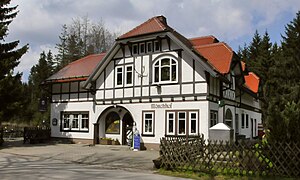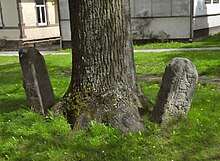Mönchhof (Thuringia)
The Waldgasthaus Mönchhof is a regionally known excursion restaurant in the Thuringian Forest near Elgersburg in the Ilm district in Thuringia .
location
The Mönchhof is located 753 m above sea level. NN at the upper end of the Jüchnitz valley on Schmücker Straße (formerly L 2645 ), which connects the property with Elgersburg and ends here. Its extension continues as a forest road to the Schmücke . It is also called Salzmannstrasse .
The Mönchhof is located on the site of a former chapel and a forester's house on the boundary between Elgersburg and Ilmenau - Manebach . The summit of the 799 m high Rumpelsberg is about one kilometer to the north-northeast , 800 meters to the east is the summit of the Bundschildskopf at a height of 785 m , in the south-southeast at 771 m the Hirschkopf and in the south-southwest the 784 m high Leimbühl .
history
Beginnings until 1877
In the Middle Ages, the Ichtershausen Monastery built a small chapel and outbuildings on the site of today's inn, in which a lay brother lived who looked after and managed the nearby monastery forest. In the course of the Reformation and with the dissolution of the Ichtershausen Monastery, the property with the chapel fell into disrepair. The only evidence of this time are the monk stones and a vaulted cellar. In addition, old field names still indicate monastery ownership: the ridge between Geraberg and Elgersburg, for example, is still called Mönchsheide today , and the forest on the western slope of the Rumpelsberg towards the Jüchnitz valley is called Mönchswald .
A wooden house was built on the foundations of the medieval chapel in 1852. It was the duty of the resident to collect tolls and to feed the hikers, craftsmen or forest workers who passed by.
From 1878
From 1878, the forester, landlord and road warden Peter Frankenberg lived in the forester's house for 27 years. He became very well known in the region through so-called deer parades : As soon as Frankenberg whistled a certain melody, the red deer came and ate out of the hand of the forester in the barn in front of the audience, old photos prove this. After his death on October 11, 1905, Frankenberg was buried in the Elgersburg cemetery.
From 1908
Due to increasing tourism, the building, now known as Mönchhof , was expanded in 1908 by a new half-timbered building under the new forester Röder from Manebach , as it can still be seen today. Four years later, after Röder retired, the history of the property as a forester's house came to an end. The Röders managed the inn for a few more years, after which other landlords followed. In 1926 the property was taken over by Röder Junior, Paul Teichmüller from Gehlberg , who turned it back into an attractive restaurant. The visitors to the Mönchhof were particularly interested in the hinds raised in gates . During and after the First World War , Teichmüller supplied the population with self-made agricultural products. He also supported the people who lacked heating coal in their search for firewood. In 1956, after 30 years, Teichmüller returned to his hometown.
1956 to 1976
Next, in 1956, his employee Hella Freund took over the restaurant for two years. The Keune couple from Geraberg became their successors. During her lease period, significant renovations and installations were carried out that made the restaurant even more successful: installation of water toilets, renovation of the kitchen rooms, roofing of the storage room, new roofing, establishment of a children's playground, only: electrical power and a public water supply were still missing, that Water came from the Hirschgrund by a gasoline-powered pump.
In 1966 Walter Ulbricht visited the Waldgasthaus and found out about this shortage. From his budget he made 80,000 marks available to cover the material costs and determined that the work should be carried out by the NAW . After 200,000 marks had been spent at the end of the work, the mayor was able to switch on the electric light on December 1, 1967 with great sympathy from numerous guests and the landlord Willy Keune extinguished the kerosene lamp. A year later, the cable had to be re-laid for 50,000 marks due to incorrect laying. Thanks to electrification, the water supply was now secured and improved. The Keunes retired as innkeepers in 1976 for reasons of age.
1976 until today
Erfurt restaurateur Lothar Eisenhardt took over the inn in 1976 and renovated it again: New windows, new wood paneling inside, new roof. In 1978 he went back to Erfurt.
From 1980 to 1991 the restaurant was run by a new operator. The political change also brought about a change in management: Since then, the Schmidt family has been running the inn.
The monk stones
As documents from the years 1221 and 1228 (in the Gotha and Magdeburg State Archives) confirm, Landgrave Ludwig IV (spouse of Saint Elisabeth ) donated around 25 hectares of forest and land to the Ichtershausen monastery. As usual, the borders of the area were marked by the monks with mighty boundary stones bearing the image of their patron saint, St. George . These stones are called monk stones .
One of four remaining stones was discovered in 1903 by the Manebach teacher Bader about 50 m away from the Mönchhof on the way to the Marienquelle, dug up together with forest warden Frankenberg and brought to the Mönchhof. It was erected in the 12th century, probably soon after the donation. The image is badly weathered. Older descriptions indicate that it showed Saint George as a relief with an inscription on the side. Georg carried a triangular shield in his left hand and a lance in his right hand and was dressed in long chain mail that reached to the knee . A halo “floated” over him . The stone stood on the east wall of the building until it was moved to its current location on September 13, 1906.
Another stone was found about 1 km in the direction of Elgersburg during electrical cable laying work and was badly damaged in the process. Some Elgersburg men repaired it with the help of "tooth seal cement" and set up the restored stone, which is very similar to the former, in Elgersburg's Lindenpark.
A third stone, which has now also found its place in the Lindenpark, once delimited the Mönchtal (today Steigertal ). It originally stood on today's Arnstädter Straße, where the Silberblick guesthouse once stood. The municipal boundary to Geratal still runs here today . In 1906 the inn fell to rubble and buried the stone under itself. After remaining on the discoverer's property, the stone came to its present location in 1960. It also resembles the two aforementioned boundary stones.
The fourth, remaining stone is on private property and is the best preserved and most beautiful. It dates from the 15th century. It is probably the stone that stands on the driveway to Elgersburg Castle.
Trivia
The traveling writer August Trinius , who triggered the Rennsteig boom, also dedicated a poem to the Mönchhof.
literature
- Own book with the chronicle of the Mönchhof
Web links
Individual evidence
- ↑ Geoservice of the Federal Agency for Nature Conservation
- ↑ Read up on the Mönchhof's website .
Coordinates: 50 ° 40 ′ 37.8 " N , 10 ° 50 ′ 0.7" E




